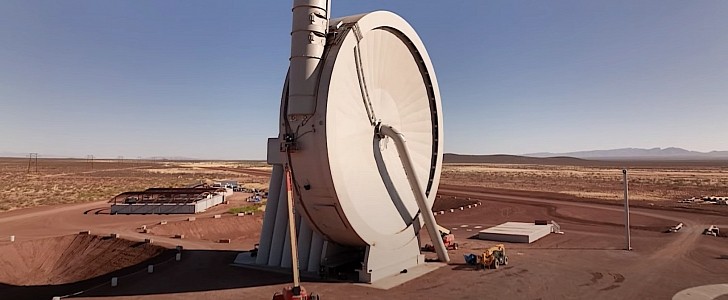Recent months have brought with them increased chatter about something called SpinLaunch. In layman terms, that would be a massive slingshot meant to throw things into space, instead of launching them the good old-fashioned way, on top of a rocket.
SpinLaunch is also how the company behind the… SpinLaunch system is called. It was founded in 2014 to create an accelerator of sorts, capable of spinning payloads at extremely high speeds, and then releasing them through a tube straight up, or at an angle, depending on needs, for them to be able to reach the desired orbit.
The accelerator is, in fact, a vacuum chamber, holding a hypersonic carbon fiber tether. The tether is powered by two powerful electric motors, which in the final version of the system should be capable of spinning the cargo at speeds of up to 5,000 mph (over 8,000 kph), or six and a half times the speed of sound, and well into hypersonic realm.
SpinLaunch is not yet at the point where it can do that, but tests are being conducted at a fraction of that speed. At the end of last week, for instance, the company conducted its eighth such attempt and the first one with an optical payload.
That means simply a camera, which was accelerated at over 1,000 mph (1,600 kph), and launched into the air with the help of a 3-meter (9.8 feet) launch vehicle.
The company even released a short video (available below) of what the camera captured during its flight, and that’s attached below. Fair warning though, there are some vertigo-inducing shots in there.
That’s because the camera started recording while inside the accelerator, being spun very fast, and the spinning motion continues during ascent. As a treat though, when the camera reaches the maximum altitude, we get a glimpse of the Earth’s curvature.
The rest of the year will see even more attempts from SpinLaunch to refine the system. First customer launches are expected to take place sometime in 2024.
The accelerator is, in fact, a vacuum chamber, holding a hypersonic carbon fiber tether. The tether is powered by two powerful electric motors, which in the final version of the system should be capable of spinning the cargo at speeds of up to 5,000 mph (over 8,000 kph), or six and a half times the speed of sound, and well into hypersonic realm.
SpinLaunch is not yet at the point where it can do that, but tests are being conducted at a fraction of that speed. At the end of last week, for instance, the company conducted its eighth such attempt and the first one with an optical payload.
That means simply a camera, which was accelerated at over 1,000 mph (1,600 kph), and launched into the air with the help of a 3-meter (9.8 feet) launch vehicle.
The company even released a short video (available below) of what the camera captured during its flight, and that’s attached below. Fair warning though, there are some vertigo-inducing shots in there.
That’s because the camera started recording while inside the accelerator, being spun very fast, and the spinning motion continues during ascent. As a treat though, when the camera reaches the maximum altitude, we get a glimpse of the Earth’s curvature.
The rest of the year will see even more attempts from SpinLaunch to refine the system. First customer launches are expected to take place sometime in 2024.











